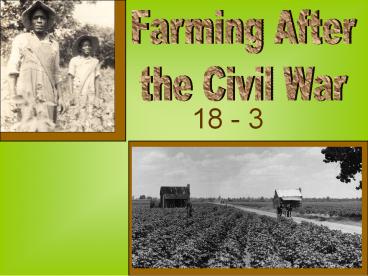18-3 Farming after the Civil War - PowerPoint PPT Presentation
1 / 13
Title:
18-3 Farming after the Civil War
Description:
18 - 3 West Texas Climate Very Dry Little annual rainfall Ranchers used windmills to pump water from underground aquifers to the surface for livestock and household use. – PowerPoint PPT presentation
Number of Views:82
Avg rating:3.0/5.0
Title: 18-3 Farming after the Civil War
1
Farming After the Civil War
- 18 - 3
2
West Texas Climate
- Very Dry
- Little annual rainfall
3
Ranchers used windmills to pump water from
underground aquifers to the surface for livestock
and household use.
4
Dry Farming
5
Railroads bring new towns
- Towns grew along the railroads route through
west central Texas - Abilene
- Sweetwater
- Big Spring
- Amarillo
6
Cotton
- Most valuable cash crop in Texas
7
The typical Texan of the late 1800s was not a
rancher.
He was a cotton farmer!
8
Proceso Martinez
- Businessman who brought cotton to the Rio Grande
Valley
9
More Texas Crops
- Wheat
- Corn
- Rice
- Sugarcane
- Honey
10
Some Farms Unsuccessful
- Boll weevil
- Grasshoppers
- Drought
- Egypt and India increased their cotton
production,
lowering the price.
(When supply goes up,
prices go down)
11
After the Civil War, many plantations were
subdivided into small farms.
- The smaller farms were either sold to new owners
or rented to tenant farmers and sharecroppers.
12
Tenant System Replaces Slavery
- Tenant farmers - rented the land and shared the
profit of whatever they grew with the land owner. - Sharecroppers - Tenant farmers who did not
provide their own seeds and tools (They rented
them from the landowner.)
13
Farmers brought more people and towns to Texas.
These grew into small communities with schools,
churches, roads, and businesses.































